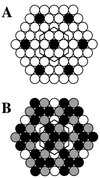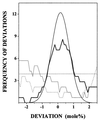Phospholipid composition of the mammalian red cell membrane can be rationalized by a superlattice model
- PMID: 9560211
- PMCID: PMC20196
- DOI: 10.1073/pnas.95.9.4964
Phospholipid composition of the mammalian red cell membrane can be rationalized by a superlattice model
Abstract
Although the phospholipid composition of the erythrocyte membrane has been studied extensively, it remains an enigma as to how the observed composition arises and is maintained. We show here that the phospholipid composition of the human erythrocyte membrane as a whole, as well as the composition of its individual leaflets, is closely predicted by a model proposing that phospholipid head groups tend to adopt regular, superlattice-like lateral distributions. The phospholipid composition of the erythrocyte membrane from most other mammalian species, as well as of the platelet plasma membrane, also agrees closely with the predictions of the superlattice model. Statistical analyses indicate that the agreement between the observed and predicted compositions is highly significant, thus suggesting that head group superlattices may indeed play a central role in the maintenance of the phospholipid composition of the erythrocyte membrane.
Figures



Similar articles
-
Mechanism and function of changes in membrane-phospholipid asymmetry in platelets and erythrocytes.Biochem Soc Trans. 1993 May;21(2):248-53. doi: 10.1042/bst0210248. Biochem Soc Trans. 1993. PMID: 8359475 Review. No abstract available.
-
Modification of host cell membrane lipid composition by the intra-erythrocytic human malaria parasite Plasmodium falciparum.Biochem J. 1991 Feb 15;274 ( Pt 1)(Pt 1):121-32. doi: 10.1042/bj2740121. Biochem J. 1991. PMID: 2001227 Free PMC article.
-
Loss of membrane phospholipid asymmetry in platelets and red cells may be associated with calcium-induced shedding of plasma membrane and inhibition of aminophospholipid translocase.Biochim Biophys Acta. 1990 Jul 24;1026(2):153-60. doi: 10.1016/0005-2736(90)90058-v. Biochim Biophys Acta. 1990. PMID: 2116169
-
Lateral organisation of membrane lipids. The superlattice view.Biochim Biophys Acta. 1999 Aug 25;1440(1):32-48. doi: 10.1016/s1388-1981(99)00106-7. Biochim Biophys Acta. 1999. PMID: 10477823 Review.
-
Red cell membrane lipids in hemoglobinopathies.Curr Mol Med. 2008 Nov;8(7):633-8. doi: 10.2174/156652408786241429. Curr Mol Med. 2008. PMID: 18991649 Review.
Cited by
-
The ESCRT-III machinery participates in the production of extracellular vesicles and protein export during Plasmodium falciparum infection.PLoS Pathog. 2021 Apr 2;17(4):e1009455. doi: 10.1371/journal.ppat.1009455. eCollection 2021 Apr. PLoS Pathog. 2021. PMID: 33798247 Free PMC article.
-
Acute Kaempferol Stimulation Induces AKT Phosphorylation in HepG2 Cells.Life (Basel). 2024 Jun 15;14(6):764. doi: 10.3390/life14060764. Life (Basel). 2024. PMID: 38929747 Free PMC article.
-
Time-resolved fluorescence and fourier transform infrared spectroscopic investigations of lateral packing defects and superlattice domains in compositionally uniform cholesterol/phosphatidylcholine bilayers.Biophys J. 2003 Jun;84(6):3777-91. doi: 10.1016/S0006-3495(03)75106-6. Biophys J. 2003. PMID: 12770884 Free PMC article.
-
Lipidomic profiling reveals distinct differences in plasma lipid composition in overweight or obese adolescent students.BMC Endocr Disord. 2021 Oct 13;21(1):201. doi: 10.1186/s12902-021-00859-7. BMC Endocr Disord. 2021. PMID: 34641844 Free PMC article.
-
The potent effect of mycolactone on lipid membranes.PLoS Pathog. 2018 Jan 10;14(1):e1006814. doi: 10.1371/journal.ppat.1006814. eCollection 2018 Jan. PLoS Pathog. 2018. PMID: 29320578 Free PMC article.
References
-
- Somerharju P, Virtanen J A, Eklund K, Vainio P, Kinnunen P. Biochemistry. 1985;24:2773–2781. - PubMed
-
- Virtanen J A, Somerharju P, Kinnunen P K J. J Mol Electron. 1987;4:233–236.
Publication types
MeSH terms
Substances
LinkOut - more resources
Full Text Sources
Miscellaneous

